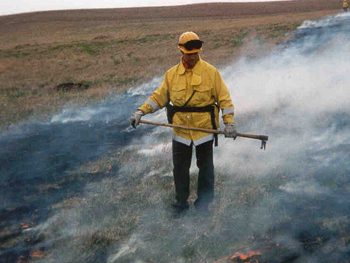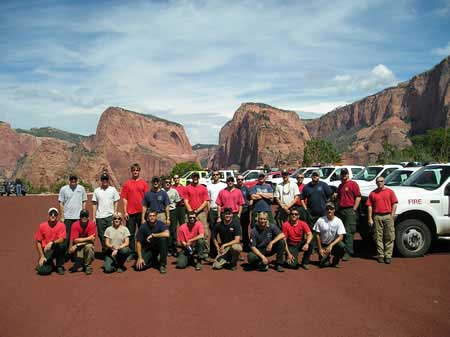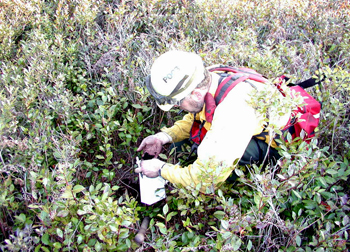What We Do
What We Do
The U.S. Fish and Wildlife Service (FWS) manages fire to conserve, protect, and enhance fish, wildlife, and plants, and their habitats while protecting FWS facilities and surrounding communities. Fire management is integrated into the FWS land management program.
The FWS manages land units in all of the 50 states, as well as all U.S. territories (in Puerto Rico, the Virgin Islands, and the Pacific Islands). The FWS fire program is responsible for protecting more land management units than any other federal agency, with nearly 75 million burnable acres; many of these are small coastal and urban tracts with extensive wildland-urban interface areas along the East, West, and Gulf Coasts and in the Midwest.
The FWS fire management program is based on a balance of needs, including prescribed burning, wildfire suppression, wildland fire use, and wildfire prevention. This involves technical expertise in firefighting and prescribed burning, as well as an understanding of fire ecology. Arguably one of the most physically arduous and dangerous natural resource professions, wildland fire management involves a combination of hazardous fuels reduction, firefighting, and wildland fire use, depending upon conditions and resource objectives outlined in the fire management plan for the specific unit.
 Restoring and maintaining all FWS lands in desirable condition by increasing prescribed burning and wildland fire use overall is the most cost-effective, long-term fire management strategy. It reduces fire risk to maximize long-term protection to communities while minimizing the costs of fire suppression and emergency rehabilitation of lands damaged by catastrophic wildfire, and maximizing available resources for fire suppression on other federal, tribal, state, and private lands.
Restoring and maintaining all FWS lands in desirable condition by increasing prescribed burning and wildland fire use overall is the most cost-effective, long-term fire management strategy. It reduces fire risk to maximize long-term protection to communities while minimizing the costs of fire suppression and emergency rehabilitation of lands damaged by catastrophic wildfire, and maximizing available resources for fire suppression on other federal, tribal, state, and private lands.
Planning
All fire management actions on FWS lands are the result of fire management plans, which are required for all land management units with burnable acres, including national wildlife refuges, waterfowl protection areas, national fish hatcheries, conservation easements, and other lands. There are currently more than 630 units in FWS that require fire management plans.
Fire management plans define the conditions and appropriate management response to be used within a designated unit, depending on the objectives outlined in the unit's land management plan, known as the Comprehensive Conservation and Habitat Management Plan.
Wildland fire use, prescribed burning and other hazardous fuels reduction methods must be specificed and pre-approved in the fire management plan as appropriate management responses. If they are not specified, or if a fire management plan is not in place, the only allowable response is aggressive suppression of wildfire.

Single Engine Air Tanker drops retardant during a wildfire at Red Rock Lakes NWR in Montana, while engine crews prepare to conduct a burnout operation around the refuge headquarters.
Preparedness and Training
FWS fire professionals provide critical support to national wildland fire preparedness and suppression efforts, while using fire on and off Service lands to protect communities and manage, enhance, and restore wildlife habitat. The FWS conforms to the highest interagency standards of training, operations, and safety, as outlined by the National Wildfire Coordinating Group (NWCG) and benefits from the expertise of other partner agencies.

A U.S. Fish and Wildlife fire crew poses for a photo snapped by a tourist at Zion National Park in Utah. The crew was on severity detail with five engines and employees from more than a dozen national wildlife refuges and wetland management districts including Big Stone, Crane Meadows, Detroit Lakes, Fergus Falls, Horicon, Litchfield, Leopold, Morris, Necedah, Neil Smith, Port Louisa, Sherburne, and Windom.
Click here to access Guiding Principles of Fire Policy
Monitoring
Monitoring fire behavior is integral to all fire suppression, wildland fire use, and prescribed fire activities. In addition, through cooperation among Service programs and with the help of other natural resource managers, FWS fire managers rely on fire-effects monitoring and research to help conduct on-going assessment and improvement of firefighting and fuels treatment effectiveness.
Monitoring plant growth before and after fire occurrence or mechanical/chemical fuels treatment is necessary to assess the response of specific invasive species, as well as threatened and endangered plants, and adjust fire management activities to meet desired land management objectives. With the help of its partners, FWS is expanding the practice of monitoring and research within its fire management program.
Read about the Effects of Invasive Alien Plants on Fire Regimes
Read about the Effects of Fire on Threatened and Endangered Plants
Read about How Plants Use Fire (And Are Used By It)

Post wildfire regrowth at Kenai National Wildlife Refuge. (USFWS)
